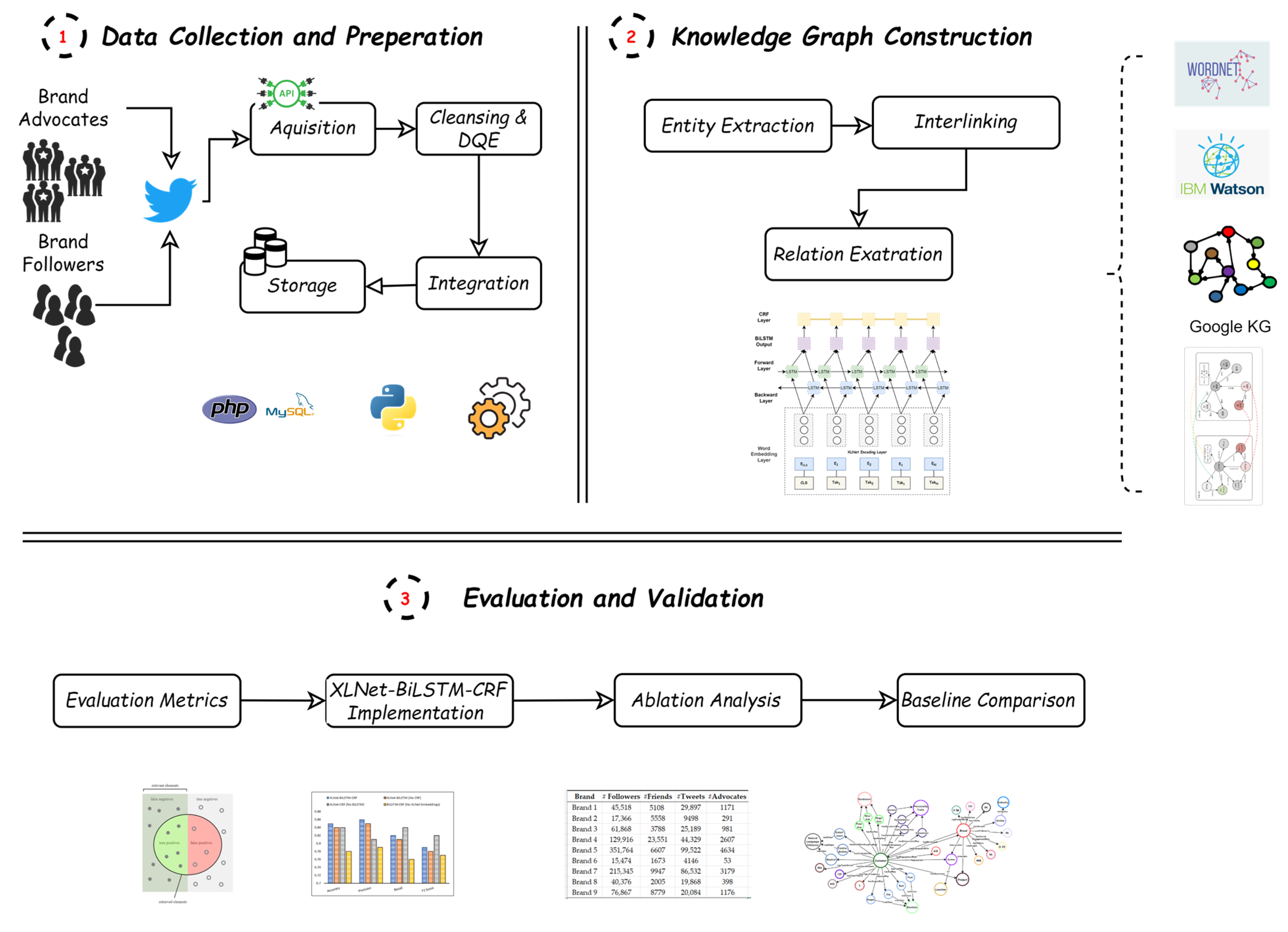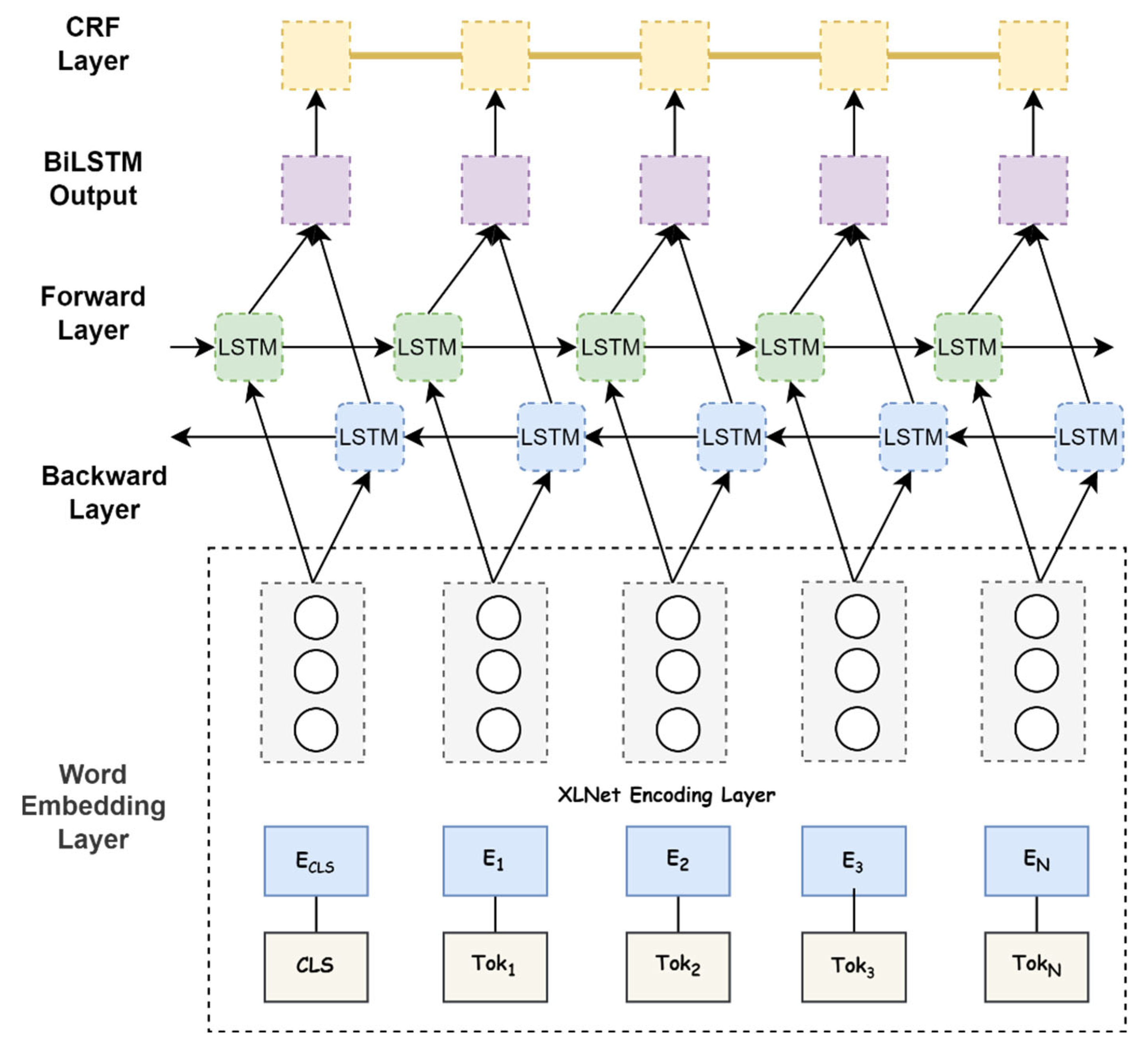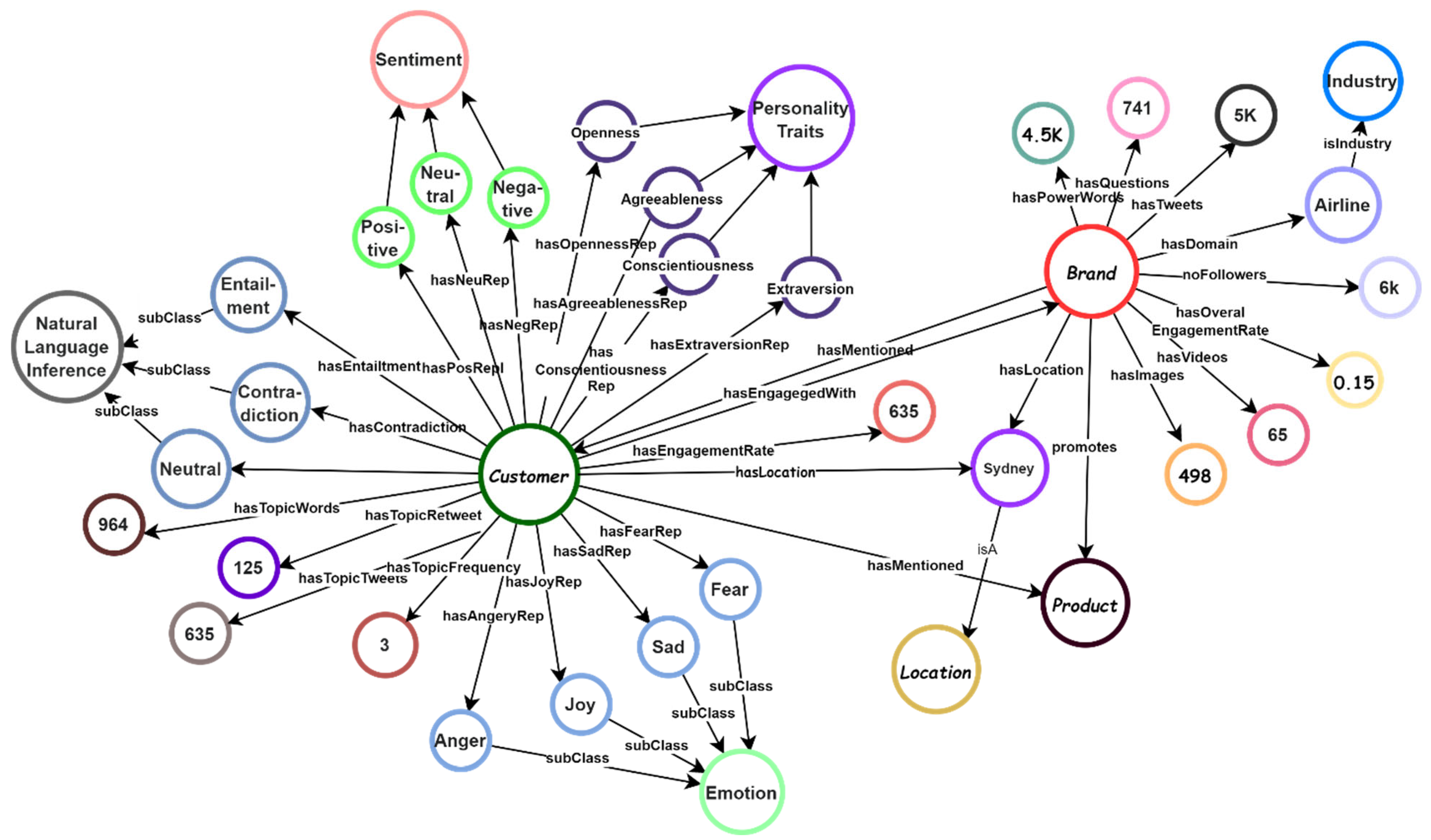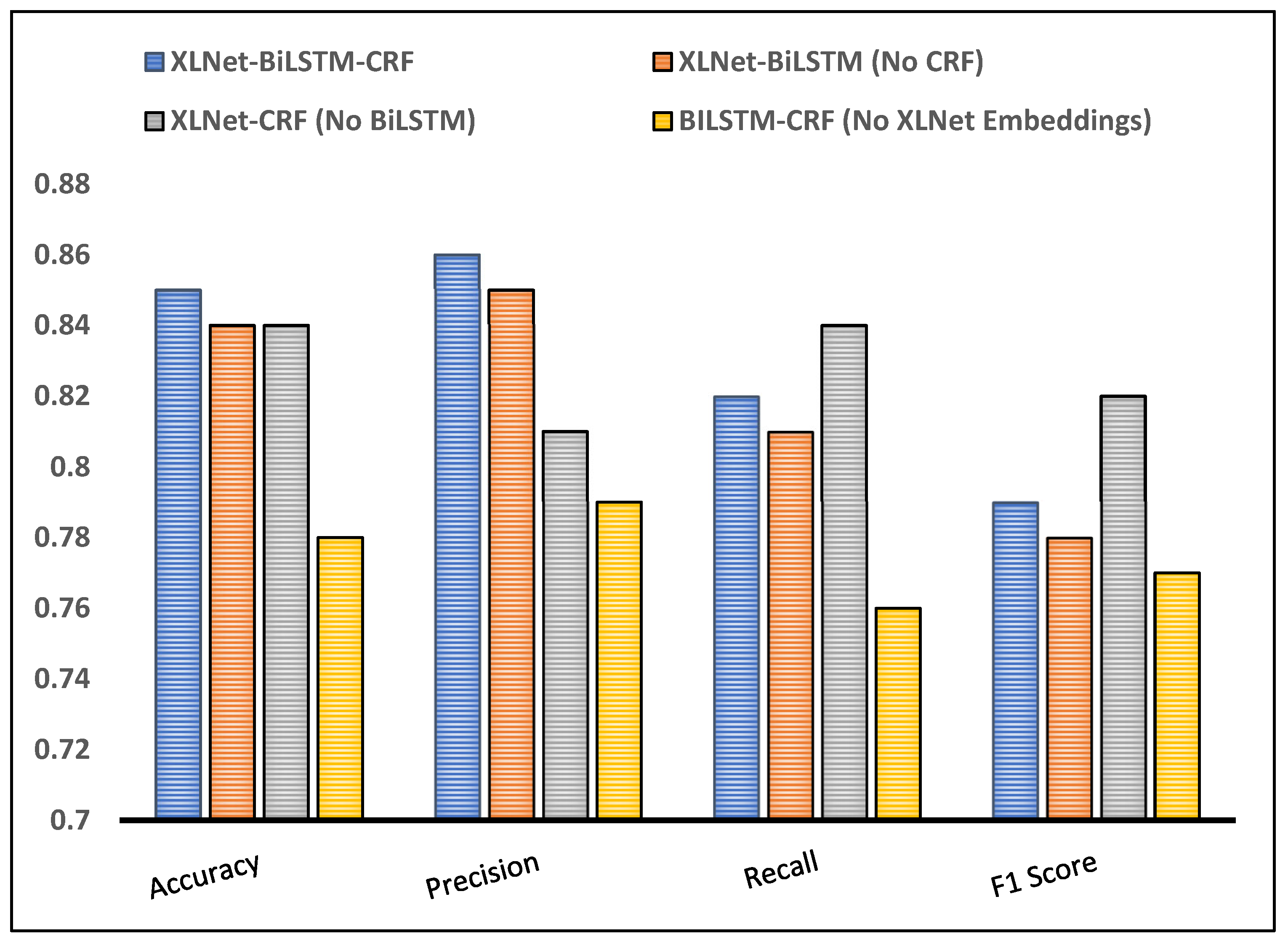Knowledge Graph Construction for Social Customer Advocacy in Online Customer Engagement
Abstract
:1. Introduction
- How can we develop an accurate and scalable method for identifying brand advocates in online social networks based on their digital behaviors and interactions?
- What is the most effective model architecture for accurately identifying brand advocates in online customer engagement, considering factors such as model complexity, training data size, and computational efficiency?
- How can the constructed KG be optimized to provide a deeper understanding of customer behavior and preferences, specifically with the goal of improving customer advocacy initiatives in online environments?
2. Related Works
2.1. Customer Advocacy in Online Environments
2.2. Social Customer Advocacy Incorporating KGs
3. Method
3.1. Data Collection and Preparation
3.2. KG Construction
3.2.1. Entity Extraction
- XLNET Layer
- BiLSTM Layer
- CRF Layer
3.2.2. Ontology Interoperability
3.2.3. Relation Extraction
3.3. Evaluation Metrics
- Accuracy: The overall accuracy of the model in correctly predicting the class labels. It can be calculated as (TP + TN)/(TP + TN + FP + FN). Accuracy provides a general measure of how well the model performs in correctly predicting both positive and negative instances.
- Precision: Precision quantifies the model’s ability to correctly identify positive instances out of all predicted positive instances. It is computed as TP/(TP + FP). Precision is important in scenarios where correctly identifying positive instances is crucial, such as identifying the correct entities relevant to brand advocacy accurately. Higher precision indicates a lower rate of false positives.
- Recall: Recall measures the model’s ability to correctly identify positive instances out of all actual positive instances. It is computed as TP/(TP + FN). Recall is important in scenarios where identifying as many positive instances as possible is crucial. A higher recall indicates a lower rate of false negatives.
- F1 Score: The F1 score is the harmonic mean of precision and recall, providing a balanced measure of the model’s performance. It is computed as 2 × (Precision × Recall)/(Precision + Recall). The F1 score combines both precision and recall, providing a single metric that balances the trade-off between the two. It is particularly useful when there is an imbalance between positive and negative instances.
- AUC-ROC: AUC-ROC measures the model’s ability to distinguish between positive and negative instances across different probability thresholds. AUC-ROC provides a comprehensive evaluation of the model’s performance by considering the trade-off between true positive rate (sensitivity) and false positive rate (1-specificity). It is useful for evaluating the model’s discriminative power.
4. Experimental Results
4.1. Dataset Exploration
4.2. XLNet-BiLSTM-CRF Implementation
4.3. Ablation Analysis
4.4. Baseline Comparison
- BERT-CNN: Combine BERT with a convolutional neural network (CNN) for named entity recognition. CNNs can capture local patterns and spatial relationships in the input sequence, complementing the contextualized embeddings provided by BERT.
- BERT-BiLSTM: Integrate BERT with a BiLSTM layer. The BiLSTM can capture sequential dependencies in the input sequence and provide additional contextual information to enhance the BERT representations.
- BERT-CRF: Combine BERT with a CRF layer. The CRF layer can model the sequential dependencies between labels and improve the overall sequence labeling performance.
- BERT-Attention Mechanism: Incorporate an attention mechanism (AT), such as self-attention or hierarchical attention, into BERT. Attention mechanisms allow the model to focus on relevant parts of the input sequence and can enhance the representational learning capability.
- BERT-Transformer-XL: Utilize the Transformer-XL model, an extension of the original Transformer architecture, in combination with BERT. Transformer-XL addresses the limitations of the fixed-length context window in the original Transformer and can capture longer-term dependencies.
- BERT-GAT: Integrate BERT with a graph attention network (GAT). GAT models can capture relational information between tokens and provide an effective way to model dependencies beyond sequential context.
- BERT-CRF-GAT: Combine BERT with both a CRF layer and a GAT layer. This combination allows for capturing both sequential dependencies and graph-based relationships, leading to enhanced named entity recognition performance.
5. Discussion
5.1. Model Performance and Ablation Analysis
5.2. Implications and Contributions
6. Conclusions
Author Contributions
Funding
Institutional Review Board Statement
Informed Consent Statement
Data Availability Statement
Conflicts of Interest
References
- Abu-Salih, B.; Wongthongtham, P.; Zhu, D.; Chan, K.Y.; Rudra, A. Social Big Data Analytics; Springer: Berlin/Heidelberg, Germany, 2021. [Google Scholar]
- Wongthontham, P.; Abu-Salih, B. Ontology-based approach for semantic data extraction from social big data: State-of-the-art and research directions. arXiv 2018, arXiv:1801.01624. [Google Scholar]
- Alnoor, A.; Tiberius, V.; Atiyah, A.G.; Khaw, K.W.; Yin, T.S.; Chew, X.; Abbas, S. How positive and negative electronic word of mouth (eWOM) affects customers’ intention to use social commerce? A dual-stage multi group-SEM and ANN analysis. Int. J. Hum.–Comput. Interact. 2022, 1–30. [Google Scholar] [CrossRef]
- Wong, A. How social capital builds online brand advocacy in luxury social media brand communities. J. Retail. Consum. Serv. 2023, 70, 103143. [Google Scholar] [CrossRef]
- Wu, S.-W.; Chiang, P.-Y. Exploring the Moderating Effect of Positive and Negative Word-of-Mouth on the Relationship between Health Belief Model and the Willingness to Receive COVID-19 Vaccine. Vaccines 2023, 11, 1027. [Google Scholar] [CrossRef]
- Araujo, T.; Neijens, P.; Vliegenthart, R. What motivates consumers to re-tweet brand content?: The impact of information, emotion, and traceability on pass-along behavior. J. Advert. Res. 2015, 55, 284–295. [Google Scholar] [CrossRef]
- Kordzadeh, N.; Young, D.K. How social media analytics can inform content strategies. J. Comput. Inf. Syst. 2022, 62, 128–140. [Google Scholar] [CrossRef]
- Menon, R.V.; Sigurdsson, V.; Larsen, N.M.; Fagerstrøm, A.; Sørensen, H.; Marteinsdottir, H.G.; Foxall, G.R. How to grow brand post engagement on Facebook and Twitter for airlines? An empirical investigation of design and content factors. J. Air Transp. Manag. 2019, 79, 101678. [Google Scholar] [CrossRef]
- Ma, L.; Ou, W.; Lee, C.S. Investigating consumers’ cognitive, emotional, and behavioral engagement in social media brand pages: A natural language processing approach. Electron. Commer. Res. Appl. 2022, 54, 101179. [Google Scholar] [CrossRef]
- Abu-Salih, B. Domain-specific knowledge graphs: A survey. J. Netw. Comput. Appl. 2021, 185, 103076. [Google Scholar] [CrossRef]
- Yang, Z.; Dai, Z.; Yang, Y.; Carbonell, J.; Salakhutdinov, R.; Le, Q.V. Xlnet: Generalized autoregressive pretraining for language understanding. Adv. Neural Inf. Process. Syst. 2019, 32, 5753–5763. [Google Scholar]
- Alsaad, A.; Alam, M.M.; Lutfi, A. A sensemaking perspective on the association between social media engagement and pro-environment behavioural intention. Technol. Soc. 2023, 72, 102201. [Google Scholar] [CrossRef]
- Bansal, R.; Pruthi, N.; Singh, R. Developing Customer Engagement through Artificial Intelligence Tools: Roles and Challenges. In Developing Relationships, Personalization, and Data Herald in Marketing 5.0.; IGI Global: Hershey, PA, USA, 2022; pp. 130–145. [Google Scholar]
- Perez-Vega, R.; Kaartemo, V.; Lages, C.R.; Razavi, N.B.; Männistö, J. Reshaping the contexts of online customer engagement behavior via artificial intelligence: A conceptual framework. J. Bus. Res. 2021, 129, 902–910. [Google Scholar] [CrossRef]
- Lim, W.M.; Rasul, T. Customer engagement and social media: Revisiting the past to inform the future. J. Bus. Res. 2022, 148, 325–342. [Google Scholar] [CrossRef]
- Ukonu, C.C.; Agu, P.C. Effect of Social Media on Consumer Buying Behaviour. Asian J. Econ. Financ. Manag. 2022, 298–309. [Google Scholar]
- Mittal, T.; Madan, P.; Sharma, K.; Dhiman, A. Delineate Omnichannel Retailer and Consumer Engagement on Social Networks. In Empirical Research for Futuristic E-Commerce Systems: Foundations and Applications; IGI Global: Hershey, PA, USA, 2022; pp. 290–303. [Google Scholar]
- Wong, A.; Hung, Y.-C. Love the star, love the team? The spillover effect of athlete sub brand to team brand advocacy in online brand communities. J. Prod. Brand Manag. 2023, 32, 343–359. [Google Scholar] [CrossRef]
- Fotheringham, D.; Wiles, M.A. The effect of implementing chatbot customer service on stock returns: An event study analysis. J. Acad. Mark. Sci. 2022, 51, 802–822. [Google Scholar] [CrossRef]
- Aljarah, A.; Sawaftah, D.; Ibrahim, B.; Lahuerta-Otero, E. The differential impact of user-and firm-generated content on online brand advocacy: Customer engagement and brand familiarity matter. Eur. J. Innov. Manag. 2022. ahead-of-print. [Google Scholar] [CrossRef]
- Kulikovskaja, V.; Hubert, M.; Grunert, K.G.; Zhao, H. Driving marketing outcomes through social media-based customer engagement. J. Retail. Consum. Serv. 2023, 74, 103445. [Google Scholar] [CrossRef]
- Ahmed, C.; ElKorany, A.; ElSayed, E. Prediction of customer’s perception in social networks by integrating sentiment analysis and machine learning. J. Intell. Inf. Syst. 2023, 60, 829–851. [Google Scholar] [CrossRef]
- Singh, N.; Upreti, M. HMRFLR: A Hybrid Model for Sentiment Analysis of Social Media Surveillance on Airlines. Wirel. Pers. Commun. 2023, 132, 97–112. [Google Scholar] [CrossRef]
- Wardhana, A.; Pradana, M.; Kartawinata, B.R.; Mas-Machuca, M.; Pratomo, T.P.; Mihardjo, L.W.W. A Twitter Social Media Analytics Approach on Indonesian Digital Wallet Service. In Proceedings of the 2022 International Conference Advancement in Data Science, E-Learning and Information Systems (ICADEIS), Istanbul, Turkey, 23–24 November 2022. [Google Scholar]
- Leung, R. Using AI–ML to Augment the Capabilities of Social Media for Telehealth and Remote Patient Monitoring. Healthcare 2023, 11, 1704. [Google Scholar] [CrossRef] [PubMed]
- Vaiciukynaite, E.; Zickute, I.; Salkevicius, J. Solutions of Brand Posts on Facebook to Increase Customer Engagement Using the Random Forest Prediction Model. In Artificiality and Sustainability in Entrepreneurship; Springer: Cham, Switzerland, 2023; p. 191. [Google Scholar]
- Kliestik, T.; Zvarikova, K.; Lăzăroiu, G. Data-driven machine learning and neural network algorithms in the retailing environment: Consumer engagement, experience, and purchase behaviors. Econ. Manag. Financ. Mark. 2022, 17, 57–69. [Google Scholar]
- Santos, Z.R.; Cheung, C.M.K.; Coelho, P.S.; Rita, P. Consumer engagement in social media brand communities: A literature review. Int. J. Inf. Manag. 2022, 63, 102457. [Google Scholar] [CrossRef]
- Nguyen, T.M.; Quach, S.; Thaichon, P. The effect of AI quality on customer experience and brand relationship. J. Consum. Behav. 2022, 21, 481–493. [Google Scholar] [CrossRef]
- Bag, S.; Srivastava, G.; Al Bashir, M.; Kumari, S.; Giannakis, M.; Chowdhury, A.H. Journey of customers in this digital era: Understanding the role of artificial intelligence technologies in user engagement and conversion. Benchmark. Int. J. 2022, 29, 2074–2098. [Google Scholar] [CrossRef]
- Zhong, L.; Wu, J.; Li, Q.; Peng, H.; Wu, X. A comprehensive survey on automatic knowledge graph construction. arXiv 2023, arXiv:2302.05019. [Google Scholar] [CrossRef]
- Zhang, N.; Xu, X.; Tao, L.; Yu, H.; Ye, H.; Qiao, S.; Xie, X.; Chen, X.; Li, Z.; Li, L. Deepke: A deep learning based knowledge extraction toolkit for knowledge base population. arXiv 2022, arXiv:2201.03335. [Google Scholar]
- Chen, X.; Zhang, N.; Xie, X.; Deng, S.; Yao, Y.; Tan, C.; Huang, F.; Si, L.; Chen, H. Knowprompt: Knowledge-aware prompt-tuning with synergistic optimization for relation extraction. In Proceedings of the ACM Web conference 2022, Lyon, France, 25–29 April 2022. [Google Scholar]
- Yu, C.; Wang, W.; Liu, X.; Bai, J.; Song, Y.; Li, Z.; Gao, Y.; Cao, T.; Yin, B. FolkScope: Intention knowledge graph construction for e-commerce commonsense discovery. In Findings of the Association for Computational Linguistics: ACL 2023; Association for Computational Linguistics: Toronto, ON, Canada, 2023. [Google Scholar]
- Yan, C.; Chen, Y.; Zhou, L. Differentiated fashion recommendation using knowledge graph and data augmentation. IEEE Access 2019, 7, 102239–102248. [Google Scholar] [CrossRef]
- Ahmad, J.; Rehman, A.; Rauf, H.T.; Javed, K.; Alkhayyal, M.A.; Alnuaim, A.A. Service Recommendations Using a Hybrid Approach in Knowledge Graph with Keyword Acceptance Criteria. Appl. Sci. 2022, 12, 3544. [Google Scholar] [CrossRef]
- Alhijawi, B.; AL-Naymat, G. Novel Positive Multi-Layer Graph Based Method for Collaborative Filtering Recommender Systems. J. Comput. Sci. Technol. 2022, 37, 975–990. [Google Scholar] [CrossRef]
- Khan, N.; Ma, Z.; Ullah, A.; Polat, K. Categorization of knowledge graph based recommendation methods and benchmark datasets from the perspectives of application scenarios: A comprehensive survey. Expert Syst. Appl. 2022, 206, 117737. [Google Scholar] [CrossRef]
- Shbita, B.; Gentile, A.L.; Deluca, C.; Li, P.; Ren, G.-J. Understanding Customer Requirements: An Enterprise Knowledge Graph Approach. In Proceedings of the European Semantic Web Conference 2023, Hersonissos, Greece, 28 May–1 June 2023. [Google Scholar]
- Pai, S.; Brennan, F.; Janik, A.; Correia, T.; Costabello, L. Unsupervised Customer Segmentation with Knowledge Graph Embeddings. In Proceedings of the Companion Proceedings of the Web Conference 2022, Lyon, France, 25–29 April 2022. [Google Scholar]
- Lee, S.-H.; Choi, S.-W.; Lee, E.-B. A Question-Answering Model Based on Knowledge Graphs for the General Provisions of Equipment Purchase Orders for Steel Plants Maintenance. Electronics 2023, 12, 2504. [Google Scholar] [CrossRef]
- Lieder, I.; Segal, M.; Avidan, E.; Cohen, A.; Hope, T. Learning a faceted customer segmentation for discovering new business opportunities at Intel. In Proceedings of the 2019 IEEE International Conference on Big Data (Big Data), Los Angeles, CA, USA, 9–12 December 2019. [Google Scholar]
- Sashi, C.; Brynildsen, G.; Bilgihan, A. Social media, customer engagement and advocacy: An empirical investigation using Twitter data for quick service restaurants. Int. J. Contemp. Hosp. Manag. 2019, 31, 1247–1272. [Google Scholar] [CrossRef]
- Wilk, V.; Sadeque, S.; Soutar, G.N. Exploring online destination brand advocacy. Tour. Recreat. Res. 2021, 1–19. [Google Scholar] [CrossRef]
- Dai, Z.; Yang, Z.; Yang, Y.; Carbonell, J.; Le, Q.; Salakhutdinov, R. Transformer-xl: Attentive language models beyond a fixed-length context. arXiv 2019, arXiv:1901.02860. [Google Scholar]
- Tripathy, J.K.; Sethuraman, S.C.; Cruz, M.V.; Namburu, A.; Mangalraj, P.; Nandha Kumar, R.; Sudhakar Ilango, S.; Vijayakumar, V. Comprehensive analysis of embeddings and pre-training in NLP. Comput. Sci. Rev. 2021, 42, 100433. [Google Scholar] [CrossRef]
- Graves, A.; Schmidhuber, J. Framewise phoneme classification with bidirectional LSTM and other neural network architectures. Neural Netw. 2005, 18, 602–610. [Google Scholar] [CrossRef]
- Sayce, D. The Number of Tweets per Day in 2022. 2022. Available online: https://www.dsayce.com/social-media/tweets-day/ (accessed on 24 September 2022).




| Brand | #Followers | #Friends | #Tweets | #Advocates |
|---|---|---|---|---|
| Brand 1 | 45,518 | 5108 | 29,897 | 1171 |
| Brand 2 | 17,366 | 5558 | 9498 | 291 |
| Brand 3 | 61,868 | 3788 | 25,189 | 981 |
| Brand 4 | 129,916 | 23,551 | 44,329 | 2607 |
| Brand 5 | 351,764 | 6607 | 99,522 | 4634 |
| Brand 6 | 15,474 | 1673 | 4146 | 53 |
| Brand 7 | 215,345 | 9947 | 86,532 | 3179 |
| Brand 8 | 40,376 | 2005 | 19,868 | 398 |
| Brand 9 | 76,867 | 8779 | 20,084 | 1176 |
| Model | Accuracy | Precision | Recall | F1 Score | AUC-ROC |
|---|---|---|---|---|---|
| BERT-BiLSTM-TextCNN | 0.86 | 0.87 | 0.85 | 0.86 | 0.92 |
| BERT-CNN | 0.82 | 0.83 | 0.81 | 0.82 | 0.88 |
| BERT-CRF | 0.88 | 0.89 | 0.87 | 0.88 | 0.94 |
| BERT-AM | 0.84 | 0.85 | 0.83 | 0.84 | 0.90 |
| BERT-Transformer-XL | 0.85 | 0.86 | 0.84 | 0.85 | 0.91 |
| BERT-GAT | 0.84 | 0.85 | 0.83 | 0.84 | 0.90 |
| BERT-CRF-GAT | 0.87 | 0.88 | 0.86 | 0.87 | 0.93 |
| XLNet-BiLSTM-CRF | 0.89 | 0.90 | 0.88 | 0.89 | 0.95 |
Disclaimer/Publisher’s Note: The statements, opinions and data contained in all publications are solely those of the individual author(s) and contributor(s) and not of MDPI and/or the editor(s). MDPI and/or the editor(s) disclaim responsibility for any injury to people or property resulting from any ideas, methods, instructions or products referred to in the content. |
© 2023 by the authors. Licensee MDPI, Basel, Switzerland. This article is an open access article distributed under the terms and conditions of the Creative Commons Attribution (CC BY) license (https://creativecommons.org/licenses/by/4.0/).
Share and Cite
Abu-Salih, B.; Alotaibi, S. Knowledge Graph Construction for Social Customer Advocacy in Online Customer Engagement. Technologies 2023, 11, 123. https://doi.org/10.3390/technologies11050123
Abu-Salih B, Alotaibi S. Knowledge Graph Construction for Social Customer Advocacy in Online Customer Engagement. Technologies. 2023; 11(5):123. https://doi.org/10.3390/technologies11050123
Chicago/Turabian StyleAbu-Salih, Bilal, and Salihah Alotaibi. 2023. "Knowledge Graph Construction for Social Customer Advocacy in Online Customer Engagement" Technologies 11, no. 5: 123. https://doi.org/10.3390/technologies11050123
APA StyleAbu-Salih, B., & Alotaibi, S. (2023). Knowledge Graph Construction for Social Customer Advocacy in Online Customer Engagement. Technologies, 11(5), 123. https://doi.org/10.3390/technologies11050123







